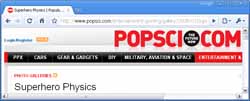Physics 101
From Encyclopedia Superheroica -the Encyclopedia of Superheroes
| (9 intermediate revisions not shown) | |||
| Line 1: | Line 1: | ||
| - | The | + | The science of superheroes. |
| - | [[Image:v3popsciphysics.jpg| | + | [[Image:v3popsciphysics.jpg|frame|From the pages of Popular Science.]] |
=Superpower Physics= | =Superpower Physics= | ||
| Line 16: | Line 16: | ||
[http://home.intranet.org/~estin/essays/comics-for-phys.txt Comics for Physicists], however, compels us to reconsider certain aspects of the actions of superheroes which we would otherwise take for granted. What <b>really</b> happens when superheroes do things in the real world? Paul A. Estin, Michael S. Schiffer, et al. have compiled a number of interesting logical exercises such as... | [http://home.intranet.org/~estin/essays/comics-for-phys.txt Comics for Physicists], however, compels us to reconsider certain aspects of the actions of superheroes which we would otherwise take for granted. What <b>really</b> happens when superheroes do things in the real world? Paul A. Estin, Michael S. Schiffer, et al. have compiled a number of interesting logical exercises such as... | ||
| - | "''REALISTIC ORIGIN COMICS: THE FANTASTIC FOUR. Flying in the first spacecraft, they and their ship are bombarded by cosmic radiation. They manage to pilot the ship back to earth, but the rays have changed them forever. That's right-- they all get radiation poisoning and die.''" | + | <blockquote> <i> "''REALISTIC ORIGIN COMICS: THE FANTASTIC FOUR. Flying in the first spacecraft, they and their ship are bombarded by cosmic radiation. They manage to pilot the ship back to earth, but the rays have changed them forever. That's right-- they all get radiation poisoning and die.''" </i> </blockquote> |
| - | [[Category: | + | ==The Physics of Superheroes== |
| - | [[Category:section | + | In <i>[http://www.physicsofsuperheroes.com The Physics of Superheroes]</i>, Professor James Kakalios (University of Minnesota) attempts to rationally explain the inexplicably fantastic powers of supeheroes. |
| + | |||
| + | <blockquote> <i> "A funny, lively look at the physics behind the superpowers of comic-book heroes. With the recent explosion in popularity of films, video games, and comic books featuring such characters as Spider-Man, Batman, and the X-Men, superheroes are more visible in our popular-culture landscape than ever before. But what would our world be like if they were real? And specifically, what feat of physics would it take to "leap tall buildings in a single bound"? </i> </blockquote> | ||
| + | |||
| + | ==Back to== | ||
| + | [[Education|EDUCATION]] subsection | ||
| + | |||
| + | [[Category:educational]] | ||
| + | [[Category:section 4]] | ||
Current revision as of 18:47, 4 August 2009
The science of superheroes.
Contents |
Superpower Physics
Superpowers are, of course, the extraordinary abilities possessed by superheroes and supervillains. Some get their powers from technology. Some get their powers from natural or supernatural sources. Whatever the case, Einstein was the first to suggest that there must be one unified theory that would explain them all. He did not find it in his lifetime, but as soon as a definitive explanation is found, we will include it here.
In the meantime, we are left to consider the possibilities. What exactly are these superpowers? Where do they come from and how do they work? What are the real effects of the actions of superheroes? Here are some of the leading theories.
Popular Science
From the pages of Popular Science comes a look at a few heroes in particular. The magazine tries to reverse-engineer the powers of Superman, Magneto, etc. They offer a few plausible explanations like: "Applying relativity (E = mc2), a single gram of mass converted completely into energy would yield 90 trillion joules. That’s 18 million lightning bolts!"
The University of Chicago
Comics for Physicists, however, compels us to reconsider certain aspects of the actions of superheroes which we would otherwise take for granted. What really happens when superheroes do things in the real world? Paul A. Estin, Michael S. Schiffer, et al. have compiled a number of interesting logical exercises such as...
"REALISTIC ORIGIN COMICS: THE FANTASTIC FOUR. Flying in the first spacecraft, they and their ship are bombarded by cosmic radiation. They manage to pilot the ship back to earth, but the rays have changed them forever. That's right-- they all get radiation poisoning and die."
The Physics of Superheroes
In The Physics of Superheroes, Professor James Kakalios (University of Minnesota) attempts to rationally explain the inexplicably fantastic powers of supeheroes.
"A funny, lively look at the physics behind the superpowers of comic-book heroes. With the recent explosion in popularity of films, video games, and comic books featuring such characters as Spider-Man, Batman, and the X-Men, superheroes are more visible in our popular-culture landscape than ever before. But what would our world be like if they were real? And specifically, what feat of physics would it take to "leap tall buildings in a single bound"?
Back to
EDUCATION subsection

